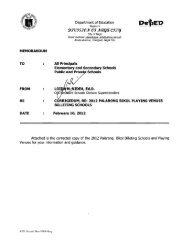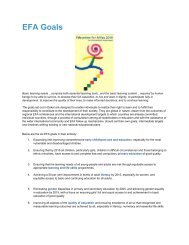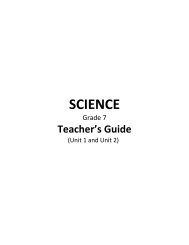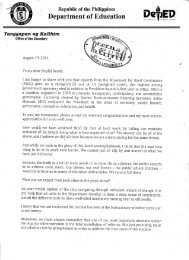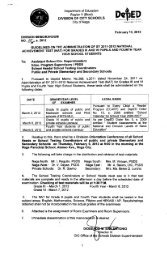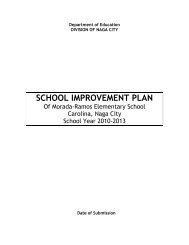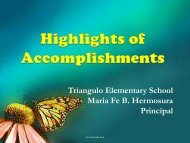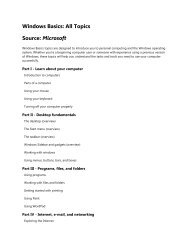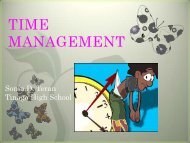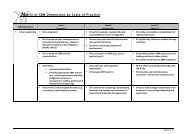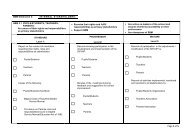pe teachers guide - DepEd Naga City
pe teachers guide - DepEd Naga City
pe teachers guide - DepEd Naga City
Create successful ePaper yourself
Turn your PDF publications into a flip-book with our unique Google optimized e-Paper software.
PHYSICAL EDUCATION<br />
Grade 1<br />
Teacher’s Guide<br />
Unit 1 and Unit 2<br />
Physical Education Teacher’s Guide 1
TEACHER’S GUIDE<br />
Physical Education Grade 1<br />
PE Strands Content Standards Performance Standards Com<strong>pe</strong>tencies<br />
Body Management<br />
and Movement<br />
Skills<br />
The learner…<br />
Demonstrates<br />
understanding of<br />
body awareness<br />
and movement<br />
skills needed for<br />
participation in<br />
physical activities<br />
The learner…<br />
Performs movement<br />
ex<strong>pe</strong>riences accurately and<br />
efficiently by:<br />
-identifying and describing parts<br />
of the body<br />
-creating sha<strong>pe</strong>s through nonlocomotor<br />
movement.<br />
-balancing one, two, three, our,<br />
five body parts<br />
-transferring weight of body<br />
parts<br />
The learner…<br />
Identifies and<br />
describes parts of<br />
the body<br />
Creates sha<strong>pe</strong>s by<br />
using nonlocomotor<br />
movements<br />
Balances on one,<br />
two, three, four,<br />
five body parts<br />
Transfers weight of<br />
body part<br />
Rhythms and<br />
Dance<br />
Demonstrates<br />
understanding of<br />
movement<br />
patterns through<br />
action songs<br />
Performs movement sequences<br />
while singing<br />
Action Songs<br />
Performs<br />
movements while<br />
singing<br />
Games and Sports<br />
Demonstrates<br />
understanding of<br />
movement<br />
activities through<br />
mimetics<br />
Imitates accurately movements<br />
of machine, animals and nature<br />
Mimetics<br />
Imitates<br />
mechanical, animal<br />
and nature<br />
movements<br />
Physical Fitness<br />
Demonstrates<br />
understanding of<br />
valuing one’s<br />
active<br />
participation in<br />
various<br />
challenging<br />
activities,<br />
Develops values-oriented task<br />
in engaging in a different<br />
challenging activities<br />
Physical Fitness<br />
Enjoys his<br />
participation in the<br />
different<br />
challenging<br />
activities<br />
Physical Education Teacher’s Guide 2
Quarter 1: Body Awareness<br />
Module 1: The Body<br />
Number of sessions : 2<br />
Time allotment<br />
: 30 minutes/session<br />
Procedure:<br />
1. Prepare the following: cassette-recorder, music ,picture of a boy/girl (as illustrated in the module), ball,<br />
chair (or any object that could be used for the introductory activity.<br />
2. Present the picture to the class. Let the students identify the body parts starting from the head down to<br />
the feet.<br />
3. .Discuss the division of the body in the context of Physical Education: head, trunk, up<strong>pe</strong>r extremities<br />
and lower extremities<br />
4. Ask students to stand up and take their position within the boundary of the classroom.<br />
5. Arrange the object /materials for the activity<br />
6. Arrange the students by column/line for the activity.<br />
7. Let the students stand, walk; use arms to carry, lift push and pull; hold object and release object refer to<br />
pages 1 and 2 of the module.<br />
Physical Education Teacher’s Guide 3
Suggestion:<br />
Walking: forward, backward<br />
Carry object/s: from one point to another; lift object, put down object<br />
Hold and release object<br />
With the use of music, Let students move around without bumping at each other picking up<br />
things, releasing it etc. they should stop when the music stops and listen to your instruction (whether to<br />
move in clockwise or counterclockwise, diagonal, etc.)<br />
8. Refer to page 3. Challenge the students to do the following by pair or by small groups<br />
identify and describe your head, shoulders, neck, back, chest, waist, hips, arms, elbows, wrists,<br />
hands, fingers, legs, knees, ankles, feet, and toes.<br />
create sha<strong>pe</strong>s by using non-locomotor movement .<br />
balance on one, two, three four and five body parts.<br />
transfer weight of body parts.<br />
9. Refer to activity on page 3<br />
Prepare the following:<br />
(post a big picture of the boy/girl<br />
flashcards with name of body parts must be ready<br />
The flashcards may include a short straw or any colored yarn to connect the word and the part<br />
Let the students match the words on flashcards with the body part on the illustration<br />
10. Ask students to do the following by pair/ small group. Let them explore the movement of each part<br />
Head it means that movements start at the neck.<br />
Moving your torso or trunk means actions or movements from the armpit to the groin<br />
The up<strong>pe</strong>r extremity would mean movements of the right and left arms (hands, lower arm, up<strong>pe</strong>r arm).<br />
Likewise the lower extremity would mean movements of the right and left legs (up<strong>pe</strong>r and lower leg, thigh<br />
and feet).<br />
Physical Education Teacher’s Guide 4
11. Introduce/ Recall “My Toes, My Knees” with the suggested movements.<br />
Refer to page 5 of the module<br />
1.My toes<br />
Point Right (Left) foot forward<br />
2.My knees<br />
Bring Right(Left) foot close to Left (Right)<br />
foot and bend knees<br />
together<br />
3.My shoulder<br />
Rotate shoulders<br />
4.My head<br />
Rotate head<br />
5.We all clap our hands<br />
together<br />
Clap both hands above the<br />
Physical Education Teacher’s Guide 5
12. Group Work<br />
Group students into 4-6 members each. Let them create their own movements for the song. Give<br />
them 5 minutes to work on this.<br />
After 5 minutes let them sing and move according to their created movements.<br />
13. Individual Activity (page 8 and 9 and 10)<br />
Worksheet 3: Body Sha<strong>pe</strong>s<br />
Directions: In their own <strong>pe</strong>rsonal space, ask students create sha<strong>pe</strong>s using their whole body. Let<br />
them count the number of body sha<strong>pe</strong>s they have created<br />
Worksheet 4:Body Bridges<br />
Directions: Explore the different ways by which you can create these ty<strong>pe</strong>s of bridges out of your body<br />
sha<strong>pe</strong>s in 5 minutes.<br />
A wide bridge<br />
A narrow bridge<br />
A short bridge<br />
A long bridge<br />
A low bridge<br />
A high bridge<br />
Ask the students how many of these bridges they were able to make. Let them rate their <strong>pe</strong>rformance<br />
by checking the appropriate box.<br />
Did 5-6 bridges<br />
Correctly within5<br />
minutes<br />
Did 4 bridges<br />
Correctly within5<br />
minutes<br />
Did 3-2 bridges<br />
Correctly within5<br />
minutes<br />
Did 1 bridge<br />
Correctly within5<br />
minutes<br />
Additional challenges for fun and fitness:<br />
1. Do the activity with a partner<br />
2. Do the activity with a small group<br />
Physical Education Teacher’s Guide 6
Worksheet 5: Body Balance<br />
Directions: Try the following balancing skills.<br />
Two arms, one leg<br />
Two legs, one arm<br />
Balance on one foot with both hands overhead, to the side<br />
From standing position raise one leg forward, sideward and<br />
backward<br />
Keep feet together<br />
And sway body to the<br />
Right Left Front and Back<br />
14. Knowledge Check (page11)<br />
Physical Education Teacher’s Guide 7
Directions: Connect the part of the body to the movements it can do.<br />
Multiple connections are allowed.<br />
1. Arm Twist<br />
2. Leg Bend/flex<br />
3. Head Swing/sway<br />
4. Shoulder Shake<br />
5. Trunk Raise<br />
1. Hand Rotate<br />
7. Feet Stretch/Extend<br />
Physical Education Teacher’s Guide 8
Module 2: Action Songs<br />
Number of sessions : 2<br />
Time allotment<br />
: 30 minutes/session<br />
Procedure:<br />
1. Do the preliminaries (checking of attendance and uniform)<br />
2. Prepare the warm-up<br />
3. Introduce the topic<br />
4. Tell students to listen and learn the lyrics of the song.<br />
5. Teach the song<br />
First Song<br />
Deep and Wide, Deep and Wide<br />
All the small boats are flowing deep and wide<br />
High and low, high and low<br />
All the small boats are flowing high and low<br />
Deep and wide, high and low<br />
All the small boats are flowing deep and wide.<br />
6. Let them create appropriate hand movements based on the lyrics.<br />
Second Song:<br />
Beep beep the small jeeps are running down the street<br />
Stop, look and listen<br />
Stop, look and listen<br />
Beep beep the small jeeps are running down the street<br />
Third Song: Let students recall their favorite Game song (example: shagidee popo) tell them to invent their<br />
own action song.<br />
7. Prepare the venue for the next activity. There should be adequate space to allow movements. (refer to<br />
page 14)<br />
Physical Education Teacher’s Guide 9
Worksheet 7: Movement Imitation<br />
Directions: Draw or describe how the following move. In a group of 5 try to <strong>pe</strong>rform the movements by<br />
forming a circle and moving clockwise.<br />
Airplane Inch Worm<br />
Train<br />
Kangaroo<br />
Bamboo Tree<br />
Butterfly<br />
Robot<br />
Crab<br />
Pro<strong>pe</strong>ller<br />
Snake<br />
Ask students how they <strong>pe</strong>rformed the mechanical and animal movements Let them circle their answer.<br />
GREAT<br />
GOOD<br />
NOT-SO-GOOD<br />
BAD<br />
8. Team Relay<br />
Divide the class into smaller group composed of 5 members. Introduce the game (refer to worksheet 8)<br />
Worksheet 8 : Animal/Mechanical Race<br />
Directions: Let the students draw lots on the animal/ mechanical movement to <strong>pe</strong>rform. Each member of the<br />
group stays in a station. One member starts the action and ends where the next player is. The game<br />
continues until the last player reaches the finish line.<br />
Physical Education Teacher’s Guide 10
Team A<br />
Example : Lame Dog Crab<br />
Team B<br />
Starting Line<br />
Curve<br />
Straight<br />
Zigzag<br />
Clockwise<br />
Counterclockwise<br />
Finish Line<br />
ask students to draw a facial expression that describes their r feeling after the game.<br />
9. Knowledge Check (refer to page 16)<br />
Directions: Draw how the following moves<br />
1. Train _____________________________<br />
2. Snake _____________________________<br />
3. Rocket _____________________________<br />
4. Hands of the Clock _____________________________<br />
5. Escalator _____________________________<br />
Physical Education Teacher’s Guide 11
6. Elevator _____________________________<br />
7. Kangaroo _____________________________<br />
8. See-Saw _____________________________<br />
Module 3: Moving with Confidence<br />
Number of sessions : 2<br />
Time allotment<br />
: 30 minutes/session<br />
1. Do the preliminaries (checking of attendance and uniform)<br />
2. Present the picture<br />
Picture of children doing different kinds of physical activities<br />
3. Ask the students the following questions:<br />
What does the illustration above tell you<br />
Can you identify the activities where you have participated in<br />
Do you love to play games<br />
“Did you know that playing and participating in other active physical activities can help improve your<br />
physical fitness and health”<br />
4. Allow student to scatter around the room with enough space to move around<br />
(Child must face north, ADD<br />
3,6,9) School<br />
NORTH<br />
Playground<br />
WEST<br />
EAST<br />
market<br />
House<br />
SOUTH<br />
Physical Education Teacher’s Guide<br />
H<br />
12
5. Introduce the clock as it relates to the various directions: north, east, west, south and the time that<br />
corresponds to it 12o clock, 3 o’clock, 6 o’clock and 9 o’clock (relate this to the facings ( right face, left<br />
face, right about face<br />
6. Let the students follow your command by saying: “right…face, left…face, etc.) or by the directions by<br />
saying “face north, south east west “ reminding them that it also corresponds to facings and directions.<br />
7. Do challenge 1<br />
Challenge 1: Imagine that you are standing at the middle of the clock and facing north (12:00 o’clock).<br />
Do the following on signal<br />
Turn right to face East where the market is. Face north again.<br />
Face left to face the playground. Face north again.<br />
Turn to your right about to face your house. Continue turning to your right until you face the north<br />
where your school is.<br />
8. Do worksheet 11. Teach the lyrics of the song. Divide the class into 3-4 equal groups. Teach the action.<br />
Once learned, ask students to practice with their group before you call them to <strong>pe</strong>rform as a class then<br />
by group<br />
Worksheet 11: Action Song<br />
Challenge 2: Ten Filipino Boys and Girls<br />
(Ten Little Indian Boys)<br />
Directions: Learn the lyrics of the song. Later your teacher will divide the class into 3-4<br />
equal groups. After memorizing the song you will be taught the action and soon you will<br />
sing and dance with your teacher.<br />
One little two little three Filipino<br />
Four little five little six Filipino<br />
Seven little eight little nine Filipino<br />
Ten Filipino Boys and Girls<br />
They jum<strong>pe</strong>d on the boat and the boat tip<strong>pe</strong>d over<br />
They jum<strong>pe</strong>d on the boat and the boat tip<strong>pe</strong>d over<br />
They jum<strong>pe</strong>d on the boat and the boat tip<strong>pe</strong>d over<br />
Ten Filipino Boys and Girls<br />
They swam across the lake and built a KUBO<br />
They swam across the lake and built a KUBO<br />
They swam across the lake and built a KUBO<br />
Ten Filipino Boys and Girls<br />
They danced around the house and said MABUHAY<br />
They danced around the house and said MABUHAY<br />
They danced around the house and said MABUHAY<br />
Ten Filipino Boys and Girls<br />
Physical Education Teacher’s Guide 13
Worksheet 12: Simple Dance<br />
9. Challenge 3: John Brown<br />
Directions: teach the steps of the dance then let them dance with the music.<br />
Walk Forward and backward<br />
Curtsy<br />
Clap: both hands, clap both hands of partner<br />
Swing partner<br />
Walk around with partner<br />
10. At the end of the session, let them do Worksheet no. 13<br />
Worksheet 13: Knowledge Check<br />
Directions: Supply the missing letter to complete the word of the correct answer.<br />
1. The sun rises every morning in the ___ A S T<br />
2. The sun sets in the W___S T<br />
3. Baguio is located in the N __R T H.<br />
4. Mt. Mayon is in the S __U T H<br />
5. The hands of the clock moves CL_CKWISE.<br />
Physical Education Teacher’s Guide 14
Quarter 2- Space Exploration<br />
Module 4: Exploring Personal and General Space<br />
Number of sessions : 2<br />
Time allotment<br />
: 30 minutes/session<br />
1. Do the preliminaries<br />
2. Ask students to look at the illustration on each box. Ask them if they can imitate them.<br />
3. By command let them do each<br />
bend/flex<br />
extend<br />
twist sway swing<br />
rotate<br />
Raise<br />
lower<br />
Physical Education Teacher’s Guide 15
4. Then say the following:<br />
The movements that you did are called axial or non-locomotor movements. They are done in your<br />
<strong>pe</strong>rsonal space or without moving away from a fixed base or location. You can do these with any body part<br />
while standing, sitting, kneeling and lying.<br />
Now, observe the illustrations below. Can you tell what the children are doing<br />
Illustrate children walking, running jumping, playing in the playground<br />
How many are walking ___<br />
How many are running ___<br />
How many are jumping ___<br />
What you have identified are only some of the locomotor movements that you can do to explore your<br />
general space. Your general space is all the space within a room or place or boundary where your body can<br />
move<br />
Locomotor movements include walking, running, hopping, jumping, sliding, gliding, leaping, galloping<br />
and skipping.<br />
Are you ready to explore your <strong>pe</strong>rsonal and general space After going through the various activities in<br />
every module, you will be able to:<br />
5. Command your students to do this. Let them stand anywhere in the venue. On signal (whistle or clap or<br />
music) let them move as commanded.<br />
Move within a large group without bumping into others or falling, while using locomotor skills<br />
Travel in straight, curved, and zigzag pathways: high, medium and low levels<br />
Execute the locomotor skills of walk, run, hop, jump and leap<br />
Create movements while singing<br />
Enjoy simple games for fun and fitness<br />
6. Let the students do worksheet no.14<br />
Worksheet 14: No Bumping, Please<br />
Directions: Do the following without bumping or colliding with your classmates.<br />
First Challenge: Walk, run, hop, leap in any direction in slow, moderate and fast pace.<br />
Second Challenge: Travel in straight, curved, and zigzag pathways on high, medium and low levels.<br />
Physical Education Teacher’s Guide 16
How did you <strong>pe</strong>rform in class today Circle the word that describes your participation in today’s<br />
activities.<br />
GREAT GOOD NOT-SO-GOOD BAD<br />
7. Prepare the venue for the next activity<br />
Worksheet 15: Treasure Map<br />
Present a big map. Ask the following:<br />
What information does the map give<br />
Do you think you can use it to find the hidden treasure How<br />
How would you like to find a treasure today<br />
Get ready!<br />
The Challenge: (give the instruction)<br />
Find your group composed of 4-5 members.<br />
Decide who plays the leader first.<br />
The leader gets the map from the teacher.<br />
Every member of the group falls in at the back of the leader.<br />
Whatever movement the leader does must be imitated by the rest of the group members.<br />
On signal, the leader uses the map to get to the destination.<br />
First card<br />
Get the treasure by following the path. Imitate the movement of an airplane to<br />
get there<br />
Second card<br />
Start here<br />
5 times hula hoop walk over<br />
a low beam<br />
Finish Line<br />
Jump over sticks<br />
evade the cones<br />
slide to<br />
Worksheet 16:<br />
Physical Education Teacher’s Guide 17
Were you able to find the treasure<br />
How well did you follow the pathways __great ___good ___not so good<br />
Directions: Check the appropriate pathways<br />
1. Passing in a round-about (rotunda)<br />
Worksheet 16: Knowledge Check<br />
Draw a rotunda with vehicles moving towards 4 street<br />
A. Straight B. curved C. zigzag<br />
2. Crossing a bridge<br />
Draw a bridge<br />
A. Straight B. curved C. zigzag<br />
3. Avoiding obstacles<br />
A. Straight B. curved C. zigzag<br />
No. of correct answers: ___3 ___2 ___ 1<br />
Physical Education Teacher’s Guide 18
Module 5: Enjoying Simple Games<br />
Number of sessions : 2<br />
Time allotment<br />
: 30 minutes/session<br />
1. Do the preliminaries<br />
2. Ask the following:<br />
Are you fond of playing games alone, with a friend, or with a group of friends<br />
Did you know that active games can help you develop or improve your fitness Which of the following<br />
have you tried Check the appropriate boxes.<br />
Tag Game (Habulan)<br />
Hula hoop<br />
___<br />
piko<br />
___<br />
Hide and seek (Taguan)<br />
___<br />
Bato bato pick<br />
___<br />
Dodge ball<br />
___<br />
___<br />
How many have you checked ___<br />
Write here the other games that you like ______________________,<br />
__________________,_____________, _________________________<br />
3. Introduce Body Part Tag (Worksheet 17)<br />
Physical Education Teacher’s Guide 19
Worksheet 17: Body Part Tag<br />
Directions: Every player is a tagger. Listen to the teacher. S/he will call the body part to tag. Once tagged,<br />
freeze and wait for the next set of game.<br />
Tagging may be done on the following body parts only:<br />
1. Right hand, Left Hand<br />
Add illustration<br />
2. Right elbow, Left Elbow<br />
Add illustration<br />
3. Right Knee, Left Knee<br />
Add illustration<br />
4. Right hip, Left hip<br />
Add illustration<br />
5. In addition to body Part Tag, do Worksheet 18 if the time <strong>pe</strong>rmits. If not introduce it in the next session<br />
Physical Education Teacher’s Guide 20
Give the directions for the challenge.<br />
Worksheet 18: Running Races<br />
First Challenge: Individual Race<br />
Choose3 classmates for a running challenge. Your teacher will set the distance.<br />
Out of the 3 challenges, how many have you won _____<br />
Second Challenge: Group Race<br />
Form a group with 5 members. Stand one after the other. On signal the first player runs<br />
towards the cone, circle it and return to the starting line. Tag the next player. The team<br />
that finish first wins the game.<br />
6. Dance Challenge. End the challenges by introducing the dance challenge<br />
Worksheet 19: Dance Challenge<br />
Directions: play a music which may be slow or fast. Ask students to dance with the beat.<br />
7. Assessment . Do worksheet no. 20:<br />
Physical Education Teacher’s Guide 21
Knowledge Check<br />
Directions: Recall the games that you have played. Answer the following questions based on your<br />
ex<strong>pe</strong>riences.<br />
Multiple answer allowed.<br />
1. What did you do to avoid being tagged<br />
a. Run fast<br />
b. Change direction quickly<br />
2. What parts of your body were tagged<br />
a. Hand<br />
b. Elbow<br />
c. Knee<br />
d. Hip<br />
3. What do you need to win the individual race<br />
a. S<strong>pe</strong>ed<br />
b. Direction<br />
4. What did your team do to win the race<br />
a. Coo<strong>pe</strong>ration<br />
b. Team work<br />
5. How did you feel after winning<br />
Physical Education Teacher’s Guide 22




